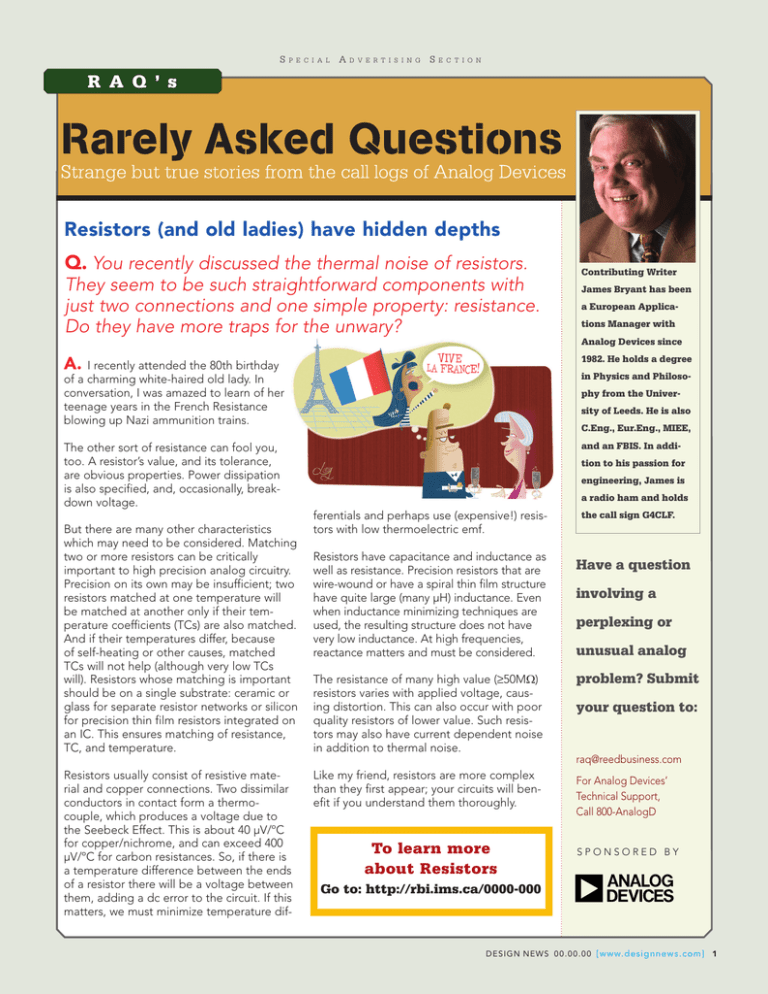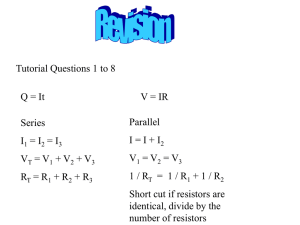Rarely Asked Questions Resistors (and old ladies) have hidden depths A.
advertisement

S p e c i a l A d v e r t i s i n g S e c t i o n R A Q ’ s Rarely Asked Questions Resistors (and old ladies) have hidden depths Q. You recently discussed the thermal noise of resistors. They seem to be such straightforward components with just two connections and one simple property: resistance. Do they have more traps for the unwary? I recently attended the 80th birthday of a charming white-haired old lady. In conversation, I was amazed to learn of her teenage years in the French Resistance blowing up Nazi ammunition trains. But there are many other characteristics which may need to be considered. Matching two or more resistors can be critically important to high precision analog circuitry. Precision on its own may be insufficient; two resistors matched at one temperature will be matched at another only if their temperature coefficients (TCs) are also matched. And if their temperatures differ, because of self-heating or other causes, matched TCs will not help (although very low TCs will). Resistors whose matching is important should be on a single substrate: ceramic or glass for separate resistor networks or silicon for precision thin film resistors integrated on an IC. This ensures matching of resistance, TC, and temperature. Resistors usually consist of resistive material and copper connections. Two dissimilar conductors in contact form a thermocouple, which produces a voltage due to the Seebeck Effect. This is about 40 µV/ºC for copper/nichrome, and can exceed 400 µV/ºC for carbon resistances. So, if there is a temperature difference between the ends of a resistor there will be a voltage between them, adding a dc error to the circuit. If this matters, we must minimize temperature dif- James Bryant has been a European Applications Manager with Analog Devices since 1982. He holds a degree A. The other sort of resistance can fool you, too. A resistor’s value, and its tolerance, are obvious properties. Power dissipation is also specified, and, occasionally, breakdown voltage. Contributing Writer in Physics and Philosophy from the University of Leeds. He is also C.Eng., Eur.Eng., MIEE, and an FBIS. In addition to his passion for engineering, James is a radio ham and holds ferentials and perhaps use (expensive!) resistors with low thermoelectric emf. Resistors have capacitance and inductance as well as resistance. Precision resistors that are wire-wound or have a spiral thin film structure have quite large (many µH) inductance. Even when inductance minimizing techniques are used, the resulting structure does not have very low inductance. At high frequencies, reactance matters and must be considered. The resistance of many high value (≥50MW) resistors varies with applied voltage, causing distortion. This can also occur with poor quality resistors of lower value. Such resistors may also have current dependent noise 1 “When you are a Bear of Very Little Brain and you think of in addition thermalthat noise. Things, you findto sometimes a Thing which seemed very Thingish inside you is quite different when it gets out into the open has other people looking at it.”complex — AA Milne, Like myand friend, resistors are more “The House at Pooh Corner” than they first appear; your circuits will ben2 Double dutch means gobbledygook 3 efit if you understand them thoroughly. Dither — the addition of noise or some other AC signal in order to randomize errors. To learn more about Resistors the call sign G4CLF. Have a question involving a perplexing or unusual analog problem? Submit your question to: raq@reedbusiness.com For Analog Devices’ Technical Support, Call 800-AnalogD SPONSORED BY Go to: http://rbi.ims.ca/0000-000 d e s i g n n e w s 0 0 . 0 0 . 0 0 [ w w w. d e s i g n n e w s . c o m ]






